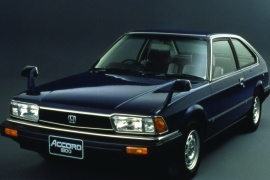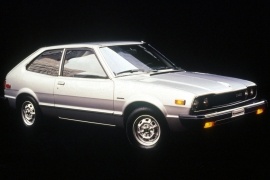HONDA Accord 3 Doors Models/Series Timeline, Specifications & Photos
First production year: 1976
Engines: Gasoline
Body style: Hatchback
In 1981 Honda introduced the second generation of the Accord for the worldwide market, and it offered it as a sedan or as a hatchback with three doors.
With its wedge shape and the sloped back, the second generation of the Accord was between the compact-sized and the mid-size segment, so most of the time, it created confusion around it. On the other hand, the coupe version was mostly a sporty compact hatchback with a sloped tailgate that offered more than a regular compact vehicle and a sportier image. The thin A, B, and C-pillars and the big window area gave the driver good visibility all around. Maybe it wasn't the safest car on the road, but it was light, nimble, and fuel-efficient. Its square headlights with corner-mounted turn-signals offered a good image to the vehicle. The Japanese carmaker didn't want to make it look upmarket. It was a common-sense vehicle with a sloped tailgate that was good for shopping and taking kids to school if there was any.
Inside, Honda installed as an option the first in-car navigation system. It wasn't a sat-nav, but it was based on a recorded map, an inertial system that worked a little bit better than a normal map on the passenger's lap. The carmaker installed good quality velour seats and a folding bench in the back to extend the trunk space.
Honda became the fourth biggest car seller in the U.S. before introducing the first generation of the Accord in 1976 and climb up the ladder of success.
Before the Accord, Honda only sold Civics and small 600s. While its cars were miles away from any comfort or performance models, they were the champs of fuel efficiency. After three years on the U.S. market, the company's management knew that the brand would need more than just tiny, mass-market vehicles, so they started to work on the Accord in 1972. The Accord shared many parts with its smaller brother Civic, but it was bigger and more spacious, although the three-door version was not the best choice for a family vehicle.
The hatchback shape with a sloped tailgate was a matter of taste, but other carmakers already had that kind of profile on the market, such as the European VW Scirocco, which appeared in 1974. At the front, the Accord featured double round headlights with a grille surrounded by a chromed trim. Its door handles were flush to the bodywork due to mandatory regulations.
Inside, there was a sense of simplicity with a rather minimalist dashboard design, where the instrument cluster featured four dials and a few warning lights. In those times, Honda didn't care too much about performance and cared more about comfort and fuel efficiency. The one-piece folding rear bench seatback was easy to operate in the back, with one hand only.
Under the hood, Honda installed a 1.6-liter engine, an evolution over the 1.5-liter unit installed in the Civic. Its cylinder-head design allowed the car to get a leaner but more efficient powerplant, which returned an excellent fuel efficiency.

